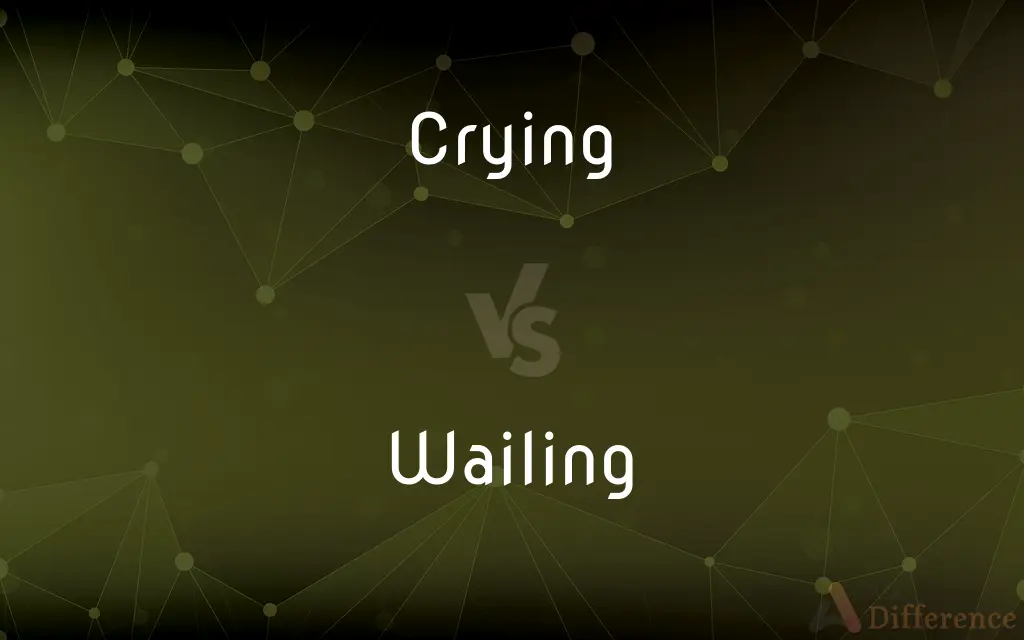Crying vs. Wailing — What's the Difference?
By Urooj Arif & Maham Liaqat — Updated on March 29, 2024
Crying is the act of shedding tears in response to an emotion, while wailing is a louder, more intense form of crying usually expressing deeper sorrow or pain.

Difference Between Crying and Wailing
Table of Contents
ADVERTISEMENT
Key Differences
Crying is a natural response to a range of emotions, from sadness and grief to joy and relief. It involves the shedding of tears from the lacrimal apparatus, without any significant vocalization. Whereas wailing is characterized by loud, prolonged vocalizations, signifying intense emotion or pain. It's often associated with profound sorrow, despair, or mourning.
Crying can occur in various contexts and intensities, from a few tears due to a minor upset to a significant emotional outburst. On the other hand, wailing is almost exclusively associated with extreme distress or grief, such as the loss of a loved one.
While crying can be a private, contained expression of feeling, wailing is typically a public display of extreme emotional turmoil. The act of wailing can serve as a call for attention or help, reaching out to others in a time of need.
Crying serves multiple purposes, including emotional release, self-soothing, and communicating distress to others. In contrast, wailing is more about expressing unbearable anguish or sorrow that cannot be contained.
Crying can be subtle and go unnoticed, especially if the person is trying to hide their emotions. Wailing, however, is hard to ignore due to its volume and intensity, often drawing attention from others around.
ADVERTISEMENT
Comparison Chart
Volume
Low to moderate, can be silent
High, very audible
Intensity
Can range from mild to intense
Always intense
Emotional Trigger
Ranges widely from sadness, frustration, to happiness
Primarily deep sorrow, despair
Public Perception
More socially acceptable and common
Often seen as a display of profound grief or pain
Purpose/Function
Emotional release, communication of need or distress
Expression of unbearable anguish, soliciting communal support
Compare with Definitions
Crying
Can be a response to physical pain or discomfort.
The child began crying after falling down.
Wailing
Indicates a higher level of distress than crying.
The intensity of his wailing showed his deep sorrow.
Crying
A way to relieve emotional stress.
He found that crying made him feel better.
Wailing
A vocal expression of extreme despair.
She was wailing inconsolably after the loss.
Crying
Sometimes used to manipulate emotions in others.
The toddler was crying to get attention.
Wailing
A loud cry of pain, grief, or anger.
Their wailing could be heard across the street after the tragic news.
Crying
A silent or audible expression of feelings.
The baby's crying alerted her parents.
Wailing
Can serve as a communal expression of grief.
The community joined in wailing for the departed elder.
Crying
Shedding tears as a response to an emotion.
She started crying after watching the touching movie.
Wailing
Often associated with mourning and funerals.
Wailing at the funeral expressed the family's profound loss.
Crying
Crying or weeping is the shedding of tears (or welling of tears in the eyes) in response to an emotional state, pain or a physical irritation of the eye. Emotions that can lead to crying include sadness, anger, and even happiness.
Wailing
To make a long, loud, high-pitched cry, as in grief, sorrow, or fear.
Crying
Demanding or requiring action or attention
A crying need.
Wailing
To make a prolonged, high-pitched sound suggestive of a cry
The wind wailed through the trees.
Crying
Abominable; reprehensible
A crying shame.
Wailing
To lament over; bewail.
Crying
That cries.
The crying child on the street was evidently lost.
Wailing
A long, loud, high-pitched cry, as of grief or pain.
Crying
That demands action or attention.
There is a crying need for more manual workers in this country.
Wailing
A long, loud, high-pitched sound
The wail of a siren.
Crying
That deserves rebuke or censure.
It is a crying shame that he managed to get away with that!
Wailing
A loud, bitter protest
A wail of misery went up when new parking restrictions were announced.
Crying
The act of one who cries; a weeping or shouting.
Their constant cryings kept us awake!
Wailing
A loud drawn out scream or howl.
Crying
Present participle of cry
Wailing
Present participle of wail
Craig ran off wailing because his friend pulled a prank on him.
Crying
Calling for notice; compelling attention; notorious; heinous; as, a crying evil.
Too much fondness for meditative retirement is not the crying sin of our modern Christianity.
Wailing
Loud cries made while weeping
Crying
The process of shedding tears (usually accompanied by sobs or other inarticulate sounds);
I hate to hear the crying of a child
She was in tears
Wailing
Vocally expressing grief or sorrow or resembling such expression;
Lamenting sinners
Wailing mourners
The wailing wind
Wailful bagpipes
Tangle her desires with wailful sonnets
Crying
Noisy with or as if with loud cries and shouts;
A crying mass of rioters
A howling wind
Shouting fans
The yelling fiend
Crying
Demanding attention;
Clamant needs
A crying need
Regarded literary questions as exigent and momentous
Insistent hunger
An instant need
Crying
Conspicuously and outrageously bad or reprehensible;
A crying shame
An egregious lie
Flagrant violation of human rights
A glaring error
Gross ineptitude
Gross injustice
Rank treachery
Common Curiosities
What is the primary difference between crying and wailing?
The primary difference is in intensity and volume, with wailing being much louder and indicative of greater distress.
Can crying be silent?
Yes, crying can be silent, with tears being the only visible sign.
Do all cultures perceive crying and wailing the same way?
No, cultural perceptions of crying and wailing vary significantly, with some cultures being more expressive than others.
Is it healthy to cry or wail?
Yes, both can be healthy emotional responses and mechanisms for coping with stress or grief.
Can men cry or wail?
Absolutely, crying and wailing are natural human responses to emotional stimuli, regardless of gender.
Does wailing have a therapeutic effect?
For some, wailing can be a cathartic expression, helping in the grieving process.
Can animals cry or wail?
Animals can produce sounds similar to wailing, often in distress, but they do not cry tears as humans do.
Is wailing always related to sadness?
While commonly associated with sadness or grief, wailing can also express other intense emotions like anger.
How do people around react to someone wailing?
Reactions can vary from empathy and support to discomfort, depending on the context and cultural norms.
Is wailing socially acceptable?
It depends on the cultural and situational context, though it's generally more accepted in situations of profound grief.
Can babies wail?
Babies can indeed wail, often as a response to discomfort or distress.
Can crying or wailing be controlled?
While it can be difficult, people can sometimes control or suppress their crying or wailing to varying degrees.
What triggers crying or wailing?
Emotional stress, physical pain, grief, and even happiness can trigger crying or wailing.
What is the social function of wailing?
Wailing can serve as a powerful expression of communal grief or solidarity in times of collective sorrow.
Is it normal to cry without tears?
Yes, this can happen, especially in cases of dehydration or when someone has cried a lot already.
Share Your Discovery

Previous Comparison
Female vs. Feminine
Next Comparison
Quran vs. BibleAuthor Spotlight
Written by
Urooj ArifUrooj is a skilled content writer at Ask Difference, known for her exceptional ability to simplify complex topics into engaging and informative content. With a passion for research and a flair for clear, concise writing, she consistently delivers articles that resonate with our diverse audience.
Co-written by
Maham Liaqat













































